Byodo-in › Four Noble Truths » Ancient origins
Articles and Definitions › Contents
- Byodo-in › Ancient History
- Four Noble Truths › Ancient History
Ancient civilizations › Historical and archaeological sites
Byodo-in › Ancient History
Definition and Origins
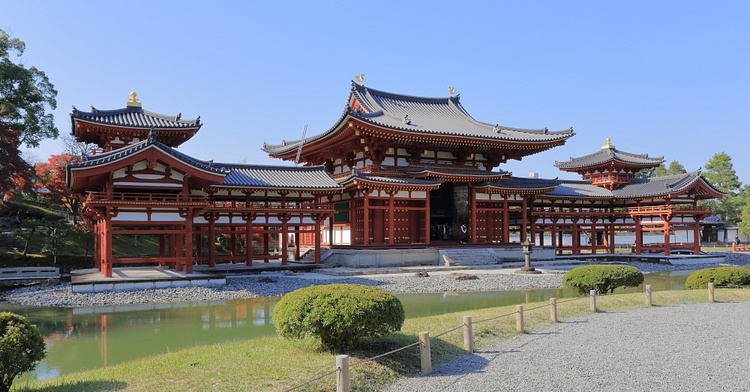
Byodo-in is a Buddhist temple complex at Uji, south of Kyoto, which was founded in 1052 CE by the important court official and regent Fujiwara no Yorimichi. The large Phoenix Hall is one of the finest surviving examples of architecture from the Heian Period (794-1185 CE) and is often referred to as the most beautiful building in Japan. Byodo-in is listed as a National Treasure of Japan and is a UNESCO World Heritage Site.
FOUNDATION & PURPOSE
The temple was founded in 1052 CE by Fujiwara no Yorimichi (992-1074 CE), leader of the powerful Fujiwara clan which dominated Japanese government in the Heian Period. Yorimichi actually built on one of the estates of his famous father Fujiwara no Michinaga (966-1028 CE), who had turned to Buddhism late in his life and built an opulent villa there in 998 CE.The date is a significant one in Buddhism as it was believed that year marked the end of an era and the beginning of a new period when decadence among the ruling class would adversely affect the appeal of Buddhism and cause a feeling of pessimism amongst the populace. Now, more than ever, an impressive Buddhist temple would be needed.
THE TEMPLE COMPLEX
The site is located to the south of Kyoto, then known as Heiankyo and the capital of Japan, in a popular area for aristocrats eager to escape the bustle of the city. Byodo-in was originally dedicated to the Buddhist bodhisattva Amida (aka Amitabha), who welcomed all comers to Paradise no matter what their branch of Buddhism. Hence, the name Byodo, which means 'equal'. The site today is a joint Jodo-Tendai temple. There were around 30 buildings at the complex at one time, but these were destroyed by fire so that only the Phoenix Hall, a bell tower whose bell is listed as a National Treasure, and the Kannon-do Hall with its wooden statue of an eleven-faced Kannon, survive from the Heian Period today. The gardens of the complex are listed as a historic site and beauty spot of Japan.
THE OVERALL & INTENTIONAL EFFECT OF THE PHOENIX HALL WAS TO REPLICATE, TO SOME DEGREE, THE SPLENDOURS OF THE BUDDHIST PARADISE.
THE PHOENIX HALL
The Phoenix Hall ( Hoo-do ), which was commissioned in 1053 CE, was originally called the Amida Hall but acquired its new name because of the resemblance of the building's tiled curving roofs to the wings of a bird. A sculpture of a gilded bronze phoenix bird stands at each end of the central roof; both are National Treasures. The large central building, which has only one floor, even if it appears from outside that there are two storeys, houses a massive gilded wood statue of Amida Nyorai (Amitabha Tathagata). The figure is 2.4 metres (7.8 ft) high and depicted seated surrounded by sculptures of 52 of his followers, bodhisattvas praying, dancing and playing musical instruments, and gilded angels attached to the white walls of the room. The sculptures were created by Jocho, a famous sculptor of the Heian Period, and the Amida is another National Treasure of Japan.
Decorative door panels and murals, 14 in total and again listed as National Treasures, display varying scenes of Amida's descent to earth and welcoming of dead souls to Paradise. Amida is accompanied by a large entourage of saints and guardian figures and the art displays the typical mix of Chinese-style figures and Japanese landscapes. Finally, the ceiling of the Hall is dominated by a large central bronze mirror made to resemble a flower with eight petals and another 86 smaller bronze mirrors.
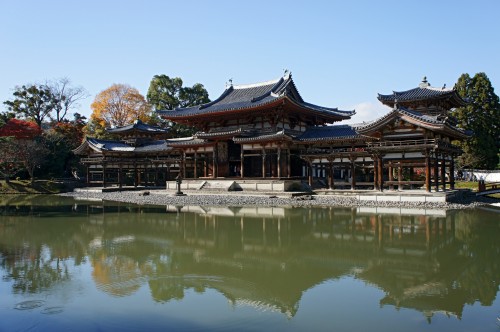
Phoenix Hall, Byodo-in
From the central building, two wings ( Yokuro ) form covered and raised walkways which extend symmetrically along the edge of a lotus pond. There is a third, shorter wing, the Biro, leading from the rear of the central hall. The Phoenix Hall is 47 metres (154 ft) in length and 13.5 metres (44 ft) tall. The building faces the east, traditionally the direction of Amida's Pure Land paradise.
The overall and intentional effect of all this architectural and artistic magnificence was to replicate, to some degree, the splendours imagined present in Paradise. The harmony of the architectural design, the reflection in the lotus pond, the gilded statues and reflected candle light in the ceiling mirrors were all produced for a certain aesthetic effect. As one Heian Period book noted, "if you are suspicious about the existence of Gokuraku [heaven], pray at the Temple in Uji." ( Zoku Honcho OraiDen ). The Phoenix Hall became a model for many subsequent Amida temples and Pure Land gardens across Japan and it remains today one of the most recognisable and esteemed buildings in the country appearing, as it does, on the Y10 coins of Japan.
This article was made possible with generous support from the Great Britain Sasakawa Foundation.
Four Noble Truths › Ancient History
Definition and Origins
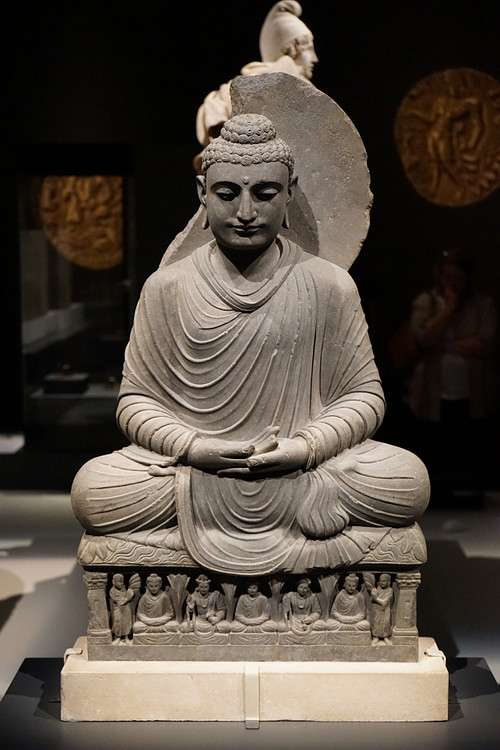
The Four Truths (Skt: catvari aryasatyani ; Pail: cattari ariyasaccani ), also commonly known as 'The Four Noble Truths ' explain the basic orientation of Buddhism. They are the truths understood by the 'worthy ones,' those who have attained enlightenment or nirvana. The four truths are dukkha (the truth of suffering); the arising of dukkha (the causes of suffering);the stopping of dukkha (the end of suffering); and the path leading to the stopping of dukkha (the path to freedom from suffering).
DUKKHA (SUFFERING)
Dukkha is defined in more detail as the human tendency to cling to or crave impermanent states or objects which keep us caught in samsara, the endless cycle of repeated birth, suffering and dying. It is thought that the Buddha taught the Four Truths in the very first teaching after he had attained enlightenment as recorded long after his physical death in the Dhammacakkappavattana Sutra ('The Discourse that Sets Turning the Wheel of Truth'), but this is still in dispute. They were recognised as perhaps the most important teachings of the Buddha Shakyamuni only at the time the commentaries were written, c. 5th century CE. On his deathbed, he also emphasised their importance:
Through not seeing the Four Noble truths
Long was the weary path from birth to birth.
When these are known, removed is rebirth's cause,
The root of sorrow plucked; then ends rebirth.( Mahaparinirvana Sutra )
Understanding or accepting transmigration (reincarnation-captivity in samsara ) and karma (all freely chosen and intended moral acts inevitably entail consequences) are a requirement of being able to embrace the Four Truths.
All rebirth is due to karma and is impermanent. Short of attaining enlightenment, in each rebirth one is born and dies, to be reborn elsewhere in accordance with the completely impersonal causal nature of one's own karma.(Williams, Buddhist Thought, 54)
The Four Truths are often best understood using a medical framework: Truth 1 is the diagnosis of an illness or condition; Truth 2 is identifying the underlying causes of it; Truth 3 is its prognosis or outcome; the 4th Truth is its treatment.
Truth 1: The Truth of Suffering
All humans experience surprises, frustrations, betrayals, etc., which lead to unhappiness and suffering. Acknowledging or accepting that we will encounter difficulties in daily life as an inevitable and universal part of life as a human being is the first truth. Within this, there are two types of suffering: a) natural suffering – disasters, wars, infections, etc.; b) self-inflicted suffering – habitual reacting and unnecessary anxiety and regret.
Truth 2: The Causes of Suffering
ALL SUFFERING LIES NOT IN EXTERNAL EVENTS OR CIRCUMSTANCES BUT IN THE WAY WE REACT TO & DEAL WITH THEM, OUR PERCEPTIONS AND INTERPRETATIONS.
All suffering lies not in external events or circumstances but in the way we react to and deal with them, our perceptions and interpretations. Suffering emerges from craving for life to be other than it is, which derives from the 3 poisons: Ignorance (Delusion) of the fact that everything, including the self, is impermanent and interdependent; Desire (Greed) of objects and people who will help us to avoid suffering; Aversion (Anger) to the things we do not want, thinking we can avoid suffering. We can learn to look at each experience as it happens and be prepared for the next.
Truth 3: The End of Suffering
We hold limiting ideas about ourselves, others, and the world, which we need to let go of. We can unlearn everything from our social conditioning and so bring down all barriers or separations.
Truth 4: The Path that Frees us from Suffering
The mind leads us to live in a dualistic way, but if we are aware of and embrace our habits and illusions, we can abandon our expectations about the ways things should be and instead accept the way they are. We can use mindfulness and meditation to examine our views and so get an accurate perspective.
This Truth contains the Eightfold Path leading out of samsara to nirvana. It consists of
- Right View ( samyag - drusti ) – acceptance of the fundamental Buddhist teachings
- Right Resolve ( samyak - samkalpa ) – adopting a positive outlook and a mind free from lust, ill-will, and cruelty
- Right Speech ( samyag -vac ) – using positive and productive speech as opposed to lying, frivolous or harsh speech
- Right Action ( samyak - karmanta ) – keeping the five precepts ( panca - sila ) – refraining from killing, stealing, misconduct, false speech, and taking intoxicants
- Right Livelihood ( samyag -ajiva ) – avoiding professions which harm others such as slavery of prostitution
- Right Effort ( samyag - vyayama ) – directing the mind towards wholesome goals
- Right Mindfulness ( samyak - smrti ) – being aware of what one is thinking, doing, and feeling at all times
- Right Meditation ( samyak -samadhi ) – focusing attention in order to enter meditational states ( dhyanas ).
These eight aspects of the path are often divided into 3 group or skandhas : 3-5 relate to morality; 6-8 to meditation; and 1-2 to insight. This eightfold path is not linear, passing from one stage to the next, but cumulative so that ideally all eight factors are practised simultaneously.
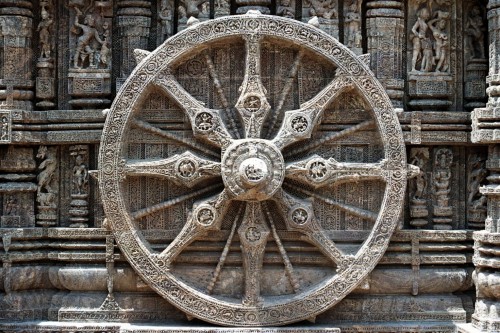
Dharma Wheel
DIFFERENT INTERPRETATIONS
There are numerous different Buddhist schools which have evolved over many centuries in different corners of the world.
Early Indian & Theravada Buddhism (the First Turning of the Wheel of Dharma)
The Buddha transcended physical existence after he died, proclaiming that he was eternally enlightened and essentially non-physical. Accordingly, the Buddha's words had only one meaning, and so the Four Truths are to be understood simultaneously in one moment of insight, not in the four distinct stages. This is liberation or enlightenment itself.
Mahayana (the Second Turning of the Wheel of Dharma)
The Four Truths became gradually less prominent because of the importance of cultivating sunyata (insight/emptiness) and taking the Bodhisattva path (of altruism or serving others).
Vajrayana or Tibetan Buddhism (the Third Turning of the Wheel of Dharma)
The Four Truths are studied from Mahayana commentaries such as Abhisamayalamkara Sutra, and the 4th Truth is presented as five aspects, not eight. These teachings also present 16 characteristics of the Four Truths taken from the sutra, providing the aspirant with greater detail to facilitate the realisation of their goals, such as awareness, achievement, pacification, and deliverance.
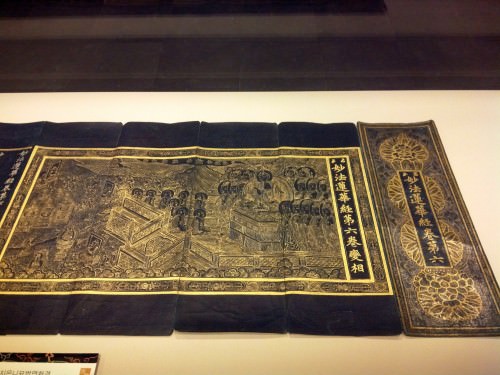
Buddhist Illuminated Manuscript, Goryeo Period
Nichiren Buddhism from Japan bases its teachings on the Lotus Sutra, the penultimate teaching of the Buddha. It states that the Four Truths are a provisional teaching which Buddha taught to suit the capacity of people of the time, while the Lotus Sutrais a direct account of Shakyamuni's own enlightenment.
THE FOUR TRUTHS TODAY
Cultivating an awareness of reality allows Buddhists to deal effectively with delusional interpretations and perceptions.Through meditation, this awareness is developed so that they can escape from samsara and take all sentient beings with them. In this way, the habitual view of the human condition can be transformed and deep insight into the meaning of life can be gained.
The fearless have crossed over the river of sorrow. Life unexamined, unobserved, unenlightened, is nothing but a river of sorrow and we are all drowning in it. (Osho,( Dhammapada ; The Way of the Buddha Vol 6. )
LICENSE:
Article based on information obtained from these sources:with permission from the Website Ancient History Encyclopedia
Content is available under License Creative Commons: Attribution-NonCommercial-ShareAlike 3.0 Unported. CC-BY-NC-SA License